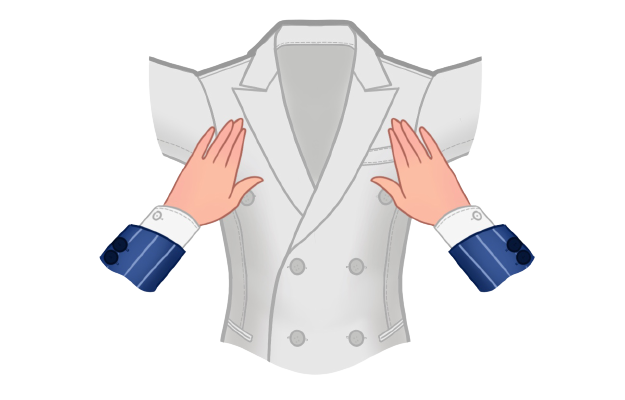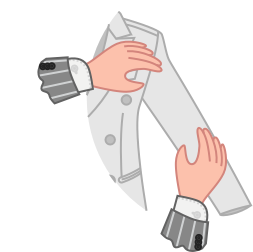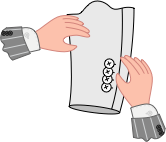SELECT YOUR FABRIC
| SEASON | SUMMER |
| COMPOSITION | 100% COTTON |
| WEIGHT | 260 GRAMS/M2 |
| COLOUR | NAVY |
| PATTERN | PLAIN |
| MILL | VANCET |

| SEASON | SPRING-SUMMER |
| COMPOSITION | 100% COTTON |
| WEIGHT | 300 GRAMS/M2 |
| COLOUR | NAVY |
| PATTERN | PLAIN |
| MILL | ERICKS |

| SEASON | FALL-WINTER |
| COMPOSITION | 100% WOOL |
| WEIGHT | 305 GRAMS/M2 |
| COLOUR | NAVY |
| PATTERN | PLAIN |
| MILL | LE PALAIS |

| SEASON | SPRING-SUMMER |
| COMPOSITION | 100%-COTTON |
| WEIGHT | 280-GRAMS/M2 |
| COLOUR | NAVY |
| PATTERN | TWILL |
| MILL | VANCET |

| SEASON | WINTER/FALL |
| COMPOSITION | 100% COTTON |
| WEIGHT | 420 GRAMS/M2 |
| COLOUR | NAVY |
| PATTERN | PLAIN |
| MILL | BROWN AARON |

| SEASON | SUMMER SEASON |
| COMPOSITION | 100% LINEN |
| WEIGHT | 340 GRAMS/M2 |
| COLOUR | CREAM BEIGE |
| PATTERN | PLAIN |
| MILL | CERRUTI |

| SEASON | WINTER-FALL |
| COMPOSITION | 100% WOOL |
| WEIGHT | 340 GRAMS/M2 |
| COLOUR | OATMEAL |
| PATTERN | PLAIN |
| MILL | VITALE BARBERIS CANONICO |

| SEASON | FALL-WINTER |
| COMPOSITION | 100% COTTON |
| WEIGHT | 300 GRAMS/M2 |
| COLOUR | OFF-WHITE |
| PATTERN | PLAIN |
| MILL | VANCET |

| SEASON | FOUR SEASON |
| COMPOSITION | 100% WOOL |
| WEIGHT | 280 GRAMS/M2 |
| COLOUR | BONE WHITE |
| PATTERN | PLAIN |
| MILL | NOBILITY |

| SEASON | FALL-WINTER |
| COMPOSITION | 100% COTTON |
| WEIGHT | 370 GRAMS/M2 |
| COLOUR | OFF-WHITE |
| PATTERN | PLAIN |
| MILL | VANCET |

| SEASON | FOUR SEASON |
| COMPOSITION | 100% WOOL |
| WEIGHT | 280 GRAMS/M2 |
| COLOUR | OLIVE GREEN |
| PATTERN | PLAIN |
| MILL | VITALE BARBERIS CANONICO |

| SEASON | SUMMER |
| COMPOSITION | 100% LINEN |
| WEIGHT | 280 GRAMS/M2 |
| COLOUR | PINK |
| PATTERN | PLAIN |
| MILL | ERICKS |

| SEASON | FALL-WINTER |
| COMPOSITION | 100% COTTON |
| WEIGHT | 360 GRAMS/M2 |
| COLOUR | RED |
| PATTERN | PLAIN |
| MILL | PONTOGLIO |

| SEASON | SUMMER |
| COMPOSITION | 100% LINEN |
| WEIGHT | 280 GRAMS/M2 |
| COLOUR | SAND BEIGE |
| PATTERN | PLAIN |
| MILL | ERICKS |

| SEASON | FOUR SEASON |
| COMPOSITION | 100% WOOL |
| WEIGHT | 280 GRAMS/M2 |
| COLOUR | TAUPE |
| PATTERN | PLAIN |
| MILL | NOBILITY |

| SEASON | SPRING-SUMMER |
| COMPOSITION | 90% COTTON 10% LINEN |
| WEIGHT | 305 GRAMS/M2 |
| COLOUR | WHITE |
| PATTERN | PLAIN |
| MILL | VANCET |

| SEASON | FALL-WINTER |
| COMPOSITION | 100% COTTON |
| WEIGHT | 295 GRAMS/M2 |
| COLOUR | WHITE |
| PATTERN | PLAIN |
| MILL | PONTOGLIO |

| SEASON | SUMMER |
| COMPOSITION | 100% LINEN |
| WEIGHT | 280 GRAMS/M2 |
| COLOUR | WHITE |
| PATTERN | PLAIN |
| MILL | ERICKS |

| SEASON | SUMMER |
| COMPOSITION | 100% LINEN |
| WEIGHT | 295 GRAMS/M2 |
| COLOUR | WHITE |
| PATTERN | PLAIN |
| MILL | KERRY KNOLL |

| SEASON | FOUR SEASON |
| COMPOSITION | 100% WOOL |
| WEIGHT | 280 GRAMS/M2 |
| COLOUR | WHITE |
| PATTERN | PLAIN |
| MILL | NOBILITY |

| SEASON | SUMMER |
| COMPOSITION | 100% COTTON |
| WEIGHT | 260 GRAMS/M2 |
| COLOUR | OFF WHITE |
| PATTERN | PLAIN |
| MILL | VANCET |

| SEASON | SPRING-SUMMER |
| COMPOSITION | 100% COTTON |
| WEIGHT | 300 GRAMS/M2 |
| COLOUR | WHITE |
| PATTERN | PLAIN |
| MILL | ERICKS |

| SEASON | SPRING-SUMMER |
| COMPOSITION | 100%-COTTON |
| WEIGHT | 280-GRAMS/M2 |
| COLOUR | WHITE |
| PATTERN | TWILL |
| MILL | VANCET |

YOUR JACKET DESIGN
jacket
Buttoning
Lapel style
Lapel Width
SPECIFY YOUR OWN Lapel Width
Vent
Construction
Shoulder
AMF
Chest pocket
Side pockets
Ticket pocket
Buttons















Cuffed sleeve
Sleeve buttons
Buttonhole lapel position
Buttonhole lapel
Lining
Lining color





+ Add Monogram
TYPE YOUR MONOGRAM
FONT STYLE
MONOGRAM COLOR





Collar felt
SIZE MEASUREMENT
BODY MEASUREMENTS
Choose this option to provide us with your body measurements and your fit preference. Our tailors will then custom make the suit to fit you accordingly.
JACKET MEASUREMENTS
Choose this option if you want a custom made jacket and you want to enter the jacket's measurements.
Need help?
Chat with us or Schedule a call
YOUR BODY MEASUREMENTS
Give us your body measurements & fit preference and let our skilful tailors do the rest of the work.

Stand straight with a normal posture. Measure your body height from tip to toe.

To measure the shoulder width correctly, we highly recommend that you put on a t-shirt. Make sure the shoulder seams (see picture) are positioned where you would like the jacket's shoulders to be positioned. Then measure from the left shoulder seam to the right shoulder seam. Also, please note that the measuring tape should do a small "curve" and follow the natural shape of your shoulders.

Measure around the thickest part of the chest and back (typically right under the armpits and across the nipples) keeping the measuring tape straight. Breath normally. It is important that the measuring tape is straight. It should be held firm to the skin, but not tight (you should be able to fit a finger between the measuring tape).

Measure around the thinnest part of the stomach/upper waist. Keep the tape straight and firm to the skin, but breathe in and out a few times to ensure this is at a comfortable width. However - if you have a bit of a rounder belly - then measure the widest point of your belly.

Put on a business shirt or t-shirt, and stand with your arms in a relaxed position. Find the spot on the shoulder where all the stitching meet (like in the picture above). This point should in the same position as when you measured the shoulder width. Then measure from that point all the way down to your wrist bone. Make sure the measurement tape follows the shape of the arm slightly. Then add +1cm/0.4in if you prefer your shirt cuff to be visible, or add +2cm/0.8in if you prefer slightly longer jacket sleeves.

Measure around the base (thickest part) of your neck. It is important that you measure at the lowest/thickest part of your neck.
ADVANCED SIZE OPTIONS

Measure around the base (thickest part) of your neck. It is important that you measure at the lowest/thickest part of your neck.

Measure the circumference of your bicep muscle (thickest point). Usually, the thickets point is quite close to the armpit.

Measure the thickets point of your forearm. Usually, this point is located slightly below your elbow.

Measure around the thickest part of your wrist, close to your hand.
JACKET FIT
WAIST LINE
-

REGULAR
If you prefer the jacket to be tight around your waist, pick Slim fit. Otherwise, if you prefer a slightly looser fit around you waist, then pick the Regular fit.
-

SLIM
If you prefer the jacket to be tight around your waist, pick Slim fit. Otherwise, if you prefer a slightly looser fit around you waist, then pick the Regular fit.
WAISTCOAT FIT
WAIST LINE
-

SLIM FIT
If you prefer the jacket to be tight around your waist, pick Slim fit. Otherwise, if you prefer a slightly looser fit around you waist, then pick the Regular fit.
-

REGULAR FIT
If you prefer the jacket to be tight around your waist, pick Slim fit. Otherwise, if you prefer a slightly looser fit around you waist, then pick the Regular fit.
LENGTH
-

LONG
-

MEDIUM
-

SHORT
Anything else we should know about your body or fit preference?
Need help?
Chat with us or Schedule a call
YOUR JACKET MEASUREMENTS
Use a jacket size that fits you as a base size for your measurements
Base Size

Step 1: Button the jacket and lay it flat on a table face down with the collar down and arms positioned downward. Use your hands to gently extend and flatten out excess fabric.

Step 2: Begin on the left side, where the top of the armhole seam meets the shoulder fold, and measure across.

Step 1: Button the jacket and lay it flat on a table face down with the collar up and arms positioned upward. Use your hands to gently extend and flatten out excess fabric.

Step 2: Starting at the lowermost point of the left armhole, measure across to the same point on the right.

Step 1: Button the jacket and lay it flat on a table face down with the collar up and arms positioned upward.
Use your hands to gently extend and flatten out excess fabric.

Step 2: Starting from the jacket's left edge, measure across at the midway point just below the first button.

Step 1: Button the jacket and lay it flat on a table face down with the collar down and arms positioned downward. Use your hands to gently extend and flatten out excess fabric. Step 2: Beginning at the center of the collar base (where the jacket’s back seam meets the collar) measure to the bottom hemline.
Step 2: Beginning at the center of the collar base (where the jacket’s back seam meets the collar) measure to the bottom hemline.

Step 1: Button the jacket and lay it flat on a table with the collar up and position the arm in a natural position. Use your hands to gently extend and flatten out excess fabric.

Step 2: Beginning at the top of the armhole seam (at the middle point of the shoulder) measure straight down through the middle of the sleeve to the sleeve edge.

Step 1: Button the jacket and lay it flat on a table with the collar up and position the arm in a natural position. Use your hands to gently extend and flatten out excess fabric.

Step 2: Beginning at the top of the armhole seam (at the middle point of the shoulder) measure straight down through the middle of the sleeve to the sleeve edge.
ADVANCED SIZE OPTIONS

Step 1: Button the jacket and lay it flat on a table with the collar up and position the arm in a natural position. Use your hands to gently extend and flatten out excess fabric.

Step 2: Measure from the center of the closing button down 15cm/6inch. Make note of this point.

Step 3: At the 15cm/6inch point, measure across from the jacket's left edge to the right edge.

Step 1: Button the jacket and lay it flat on a table with the collar up and position the arm in a natural position. Use your hands to gently extend and flatten out excess fabric.

Step 2: Starting at the highest point of the jacket, where the collar meets the shoulder seam, measure all the way down to the edge of the jacket.

Step 1: Lay the completely buttoned jacket flat on a table facing up with the collar up, and the arms positioned to the side. Use your hands to gently extend and flatten out excess fabric.

Step 2: Beginning at the edge of the armhole seam (at the armpit point) measure horizontality the distance between this point and the edge of the sleeve.

Step 1: Lay the buttoned cuff facing up. Use your hands to gently extend and flatten out excess fabric.

Step 2: Begin on the left at the widest point (sleeve side), to the same point on the other side using the cuff edge as a guide.


Back leaning posture: A posture is considered backward leaning if the shoulder stance tilts backwards compared with the rest of the torso, causing the back of the jacket to be longer than the front. This alteration will increase the length of the jacket in the front and shorten the length of the jacket in the back to balance the hemline.

Forward leaning posture: A posture is considered forward leaning if the shoulder stance tilts forward compared with the rest of the torso, causing the front of the jacket to be longer than the back. This alteration will increase the jacket's length in the back and shorten it in the front to balance the hemline.


